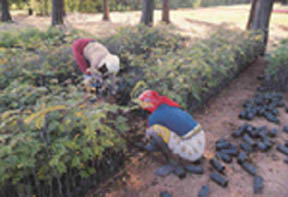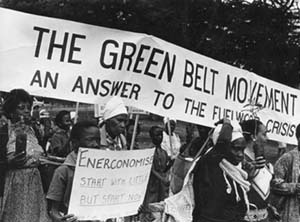WOMENAID µ INTERNATIONAL |
|
THE GREEN BELT MOVEMENT |
|
REFORESTATION IN KENYA The Green Belt Movement, a programme initiated by Professor Wangari Maathai and the National Council of Women of Kenya (NCWK), performs a double duty in organising the planting of trees. It both reduces the effects of deforestation and provides a forum for women to be creative and effective leaders. Working with Green Belt gives women the ability to change their environment and make their own decisions. The movement also involves the transfer of technology from experts to the people, turning small scale farmers into agro-foresters. Ideally, public awareness is raised on issues related to environment and development, and meetings related to tree planting activities encompass discussions on the relationships between food, population and energy. |
|
| The promotion of a positive image of women is one of the most important goals of the NCWK and its Green Belt Movement. Involving women as equal participants and developers of the Green Belts leads to a positive self-image for women, and consequently provides models of significant female achievement. Trained to properly plant and cultivate seedlings, women both assist in reforestation and generate a source of income for themselves. | 
|
|
The seedlings are sold to the organisation and then redistributed at no charge. Self-sufficiency for communities in terms of wood fuel also reduces the daily burdens on Kenyan women. Often the ravages of deforestation require women to search hours and miles for wood, while the daily requirements exceed the supply a woman can carry on her back. Integrating the physically disabled population and young people who leave school represents another objective of the Green Belt movement. Organisers hope that by becoming involved, these individuals will be encouraged to remain in their communities, rather than migrating to the urban areas in search of jobs or charity. The time that these groups have to devote to care of the trees provides a reciprocal benefit to the organisation. The most direct objective, however, involves the programme's impact on the environment. The Green Belt Movement aims to create an understanding of the relationship between the environment and other issues such as food production and health. Education serves a critical role. Children gain exposure through Green Belt projects at their schools; small farmers learn to appreciate the connections between forestry, soil conservation and their own needs for wood. If an individual or group learns of the Green Belt Movement and wishes to participate, the interested party must first prepare the available land to meet Movement specifications. A member of the Green Belt staff inspects and approves the resulting holes before an application can be filled out. Before the planter receives any trees, a Green Belt Promoter discusses the physical demands and maintenance requirements of new seedlings. Care is taken to ensure a thorough understanding of participants' obligations and thus foster a high survival rate for the trees. An extensive follow-up procedure also promotes success. The Green Belt Rangers, often physically disabled individuals, periodically check the progress and care of the trees and offer advice on any problems. When a large green belt is planned, the organisation attempts to have a ceremony with important guests of honour, to emphasise the significance of the event and heighten community awareness of the project. Such activities also provide the National Council of Women, Kenya, with an opportunity to meet community leaders and establish critical ties between the women's group and other organisations. |
|
|
|
Women's image has been enhanced through public exposure and public awareness of environmental issues has also been increased. Thousands of letters have been written expressing interest in the project. The Green Belt Movement in Kenya provides a means to reforest the land as it promotes a variety of social issues. Involving the whole population, from children to the disabled to farmers to women, proves that much can be accomplished through grassroots projects that respond to a multitude of needs. |
| It confirms the essential connections between the improvement of women's condition and the needs of society as a whole. In recognition of the great achievements of the Green Belt Movement Professor Wangari Maathai was presented with a WomenAid Woman of the World Award in 1989. | |
REturn to: DEVELOPMENT or press info library |
|
|
WOMENAID |
|
